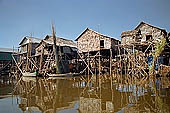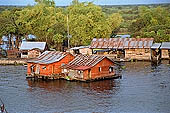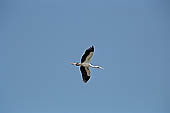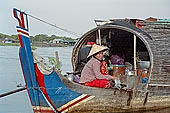| enter keyword to search: |
|
Images db
|
|
|
Articles db
|
|
|
|
|
|
|
|
|
Tonle Sap ‘the Great Lake’ is one of the largest freshwater lakes in Asia. During the dry season the Lake normally drain into the Tonle Sap River, eventually merging with the Mekong River at the 'chaktomuk' confluence. in June/July when the monsoon begins, the waters of the Mekong River, bloated by the snow melt from the Tibetan Plateau, rises substantially enough to divert part of its flow into the Tonle Sap River. At the height of monsoon, in September, the lake surface expands of more than five-fold, inundating the surrounding forested flood plain, its depths increase from a mere two meters to as deep as ten meters. The Tonle Sap is one of the most fish abundant lakes in the world, the lake margins are a particularly favourable place for settlement by rice farmers and fishers. It is no surprise that Khmer, one of Asia’s greatest ancient civilizations, developed near its north-western shore and today much of Cambodia’s livelihood still depends on its output. Overlooking the lake from NE the hill where the Phnom Krom is built, according to the legend the hill was discovered by monkey general Hanuman during his hunt for medicine in the Ramayana epic.
Tonle Sap is a wetland of international importance for biodiversity conservation. Nearly two thirds of the lake flood plain is covered by the wetland forest sustaining over 200 species of fish, more than 100 varieties of water birds including several endangered species, as well as crocodiles, turtles, macaques, otter and other wildlife.
Tonle Sap |

|
Floating Communities
The richness of natural resources of Tonle Sap favours human settlements with floating villages, towering stilted houses and huge fish traps. Floating villages were established hundred years ago to exploit fishery. Since then, their traditional way of life does not change too much. Major source of income includes fish cage culture, crocodile and snake farming; the lake supports the world's largest snake harvest. The lake provides more than half of the fish consumed in Cambodia, extensive poaching, and unfortunately illegal and destructive fishing techniques clearing for agriculture, fires, cutting for firewood, all contributes to deplete the flooded forest. Exotic invasive plants, such as water hyacinth or giant mimosa, colonize degraded areas. Beyond these, a series of hydroelectric dams under construction on the Chinese Mekong are expected to significantly disturb the hydrological cycle of the lake, and probably will result in the loss of this unique ecosystem.
The Tonle Sap Lake was nominated as Biosphere Reserve in October 1997 by UNESCO.

|
Tonle Sap
|
Prek Toal "bird sanctuary"
The north-western side of the Tonle Sap, is one of the most intact areas of freshwater swamp forest around the lake. Adapted to withstand seasonal variation of water level of up to 10 m, the inundated forest consists of short-tree shrubs and gallery forests of 7-15 m tall trees. As the dry season progresses (January to May), and the water recedes, large water birds are seen congregating on top of trees forming bird colonies, the largest most important - and in some cases the only - water birds breeding populations in Southeast Asia. The water bird colonies of Prek Toal contain some of the world's largest numbers of: Asian Openbill Stork, Painted Stork, Black-headed Ibis, Spot-billed Pelican, Lesser and Greater Adjutant, Milky Stork, Darter, Grey-headed Fish Eagle, Masked Finfoot and many more. Based on its botanical diversity and its nesting colonies of threatened water birds the area has been designated as a core area of the Tonle Sap Biosphere Reserve.
Tonle Sap |

|
The most accessible village and the nearest to the bird sanctuary, Prek Toal is located about an hour of boat trip west of Chong Khneas. It is a small fishing community situated along the Sang Ke River, the water way to Battambang. Families live in floating houses on a bamboo rafts or in houseboats, an adaptation to the ebb and flow of the lake, Villagers conduct subsistence fishing in non-restricted areas, about half of them depend upon fishing. Fishing take place during the migration out of the flooded forest with the lake's ebb, kilometre-long bamboo fences are raised along the lakeshore to channel the fish into huge traps. In the late 1990s bird colonies were threatened with extinction as a result of eggs and chicks harvesting. Subsequent protection programs allowed birds population to recover with the former poachers now employed in conservation activities. Unfortunately recent tourism and commercial pressures have begun to change traditional village life.
At the edge of the lake, Chong Khneas is the closest and most accessible floating village to Siem Reap. The ferry between Phnom Penh and Siem Reap dock here. While interesting, the village is not as picturesque and unspoiled.

|
Tonle Sap
|
Kampong Phluk flooded forest
Kampong Phluk is a cluster of stilted houses built within the floodplain of the Tonle Sap, southeast of Siem Reap. Flooded mangrove forest surrounds the area home to a variety of wildlife including crab-eating macaques. During the dry season when the lake is low, the stilted homes in the villages soar six meters above the ground, residents climbing ladders to enter their homes. At this time of year many of the villagers move out onto the lake and build temporary stilted houses. In the wet season when water level rises again, the villagers move back to their permanent houses on the floodplain, the stilts now hidden under the water. Economy is based in fishing and in shrimp harvesting. We reached Kampong Phluk during the dry season by road with a combination of car and moto and finally by boat. Many villagers, mostly teenagers, are at work catching small fish. Ethnically, the village is Khmer, people are friendly, smiles from everybody, among long canoes serving as public buses and small family pirogues as we reach the town’s main street. Amidst the hundred houses the village has a pagoda. After a brief tour of the village we headed for the nearby flooded forest.
| |
|
|
 |
|
|



